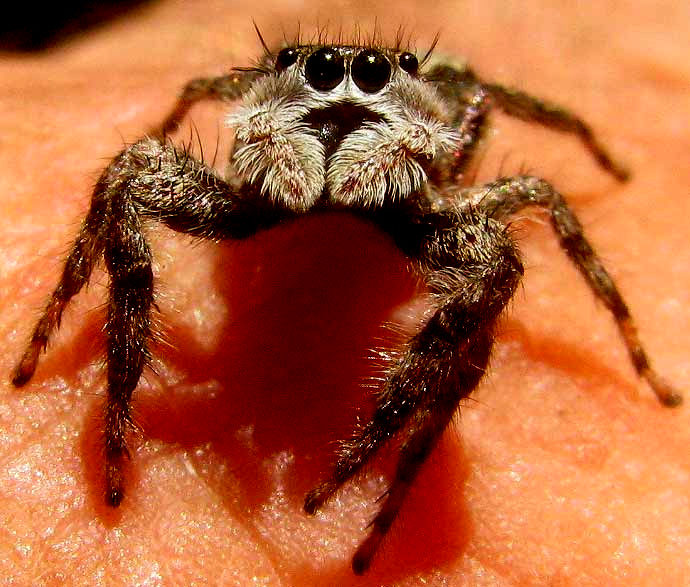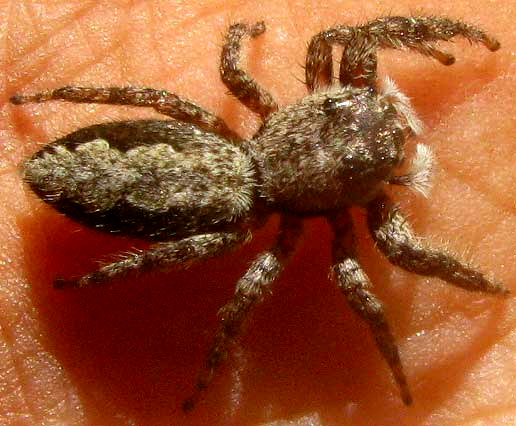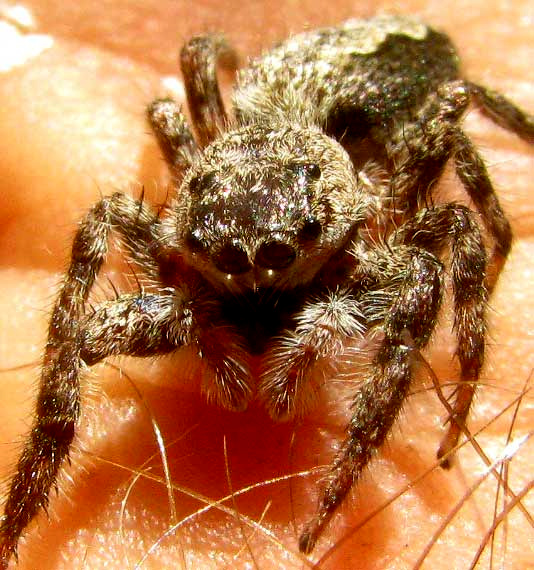Excerpts from Jim Conrad's
Naturalist Newsletter

from the June 15, 2014 Newsletter issued from the Frio Canyon Nature Education Center in the valley of the Dry Frio River in northern Uvalde County, southwestern Texas, on the southern border of the Edwards Plateau; elevation ~1750m (~5750 ft); N29.62°, W99.86°; USA
TAN JUMPING SPIDER
While painting a house, a jumping spider came climbing up a drop cloth I had covering a window. Jumping spiders are famous for reciprocating the curiosity shown by humans examining them, so I placed my hand immediately in front of the spider, who instantly jumped onto it, offering the view seen below.

Last November we looked at the Carolina Jumping Spider, Phidippus carolinensis, which I remembered as looking pretty much like this one. You can compare the picture of that one with what's in our current picture at http://www.backyardnature.net/n/a/jumpspid.htm.
Once I compared the pictures it was easy to see that the patterns on the abdomens were a little different, and the spiders' shapes differed, too. So, off this week's pictures went to volunteer identifier Bea in Ontario.
Bea, using BugGuide.Net's "browse-button technique" described here a couple of weeks ago, decided that this time we had what's sometimes called the Tan Jumping Spider, PLATYCRYPTUS UNDATUS. Tan Jumping Spiders are fairly widely distributed across the Eastern States and adjacent Canada, west to Wisconsin and Texas, south through Mexico into Guatemala.
Besides jumping spiders being among the most handsome of spiders, they're also known to have excellent vision -- among the best eyes of all invertebrate animals. Their eight relatively large eyes are arrayed on their front body section, or cephalothorax, in a way helping the spider see all around and judge distances acutely. A shot showing the arrangement of our spider's eyes appears below:

Among jumping spiders it's typical that two especially large eyes occupy the front-most position on the cephalothorax, and that a widely spaced pair of much smaller eyes is set fairly far back -- seen in the head-on view at the top of this page -- a picture taken an instant before he jumped onto the camera's lens!
In that picture the two pale, very fuzzy little arm-like items below the face are not legs, but rather "pedipalps," also called palps. They're used to feel and manipulate, plus they bear sensitive chemical detectors and serve as taste and smell organs, supplementing similar tasting and smelling done by the legs.
Jumping spiders are members of the Jumping Spider Family, the Salticidae, the largest of all spider families, embracing about 500 genera and 5000 species -- about 13% of all spider species, and mostly found in the tropics. Instead of building webs for catching prey, jumping spiders range about, often on vertical surfaces like my drop cloth. Right before jumping they anchor a strand of silk to something solid, so if they miss their target they return to their original spot by following or maybe climbing the silk strand.